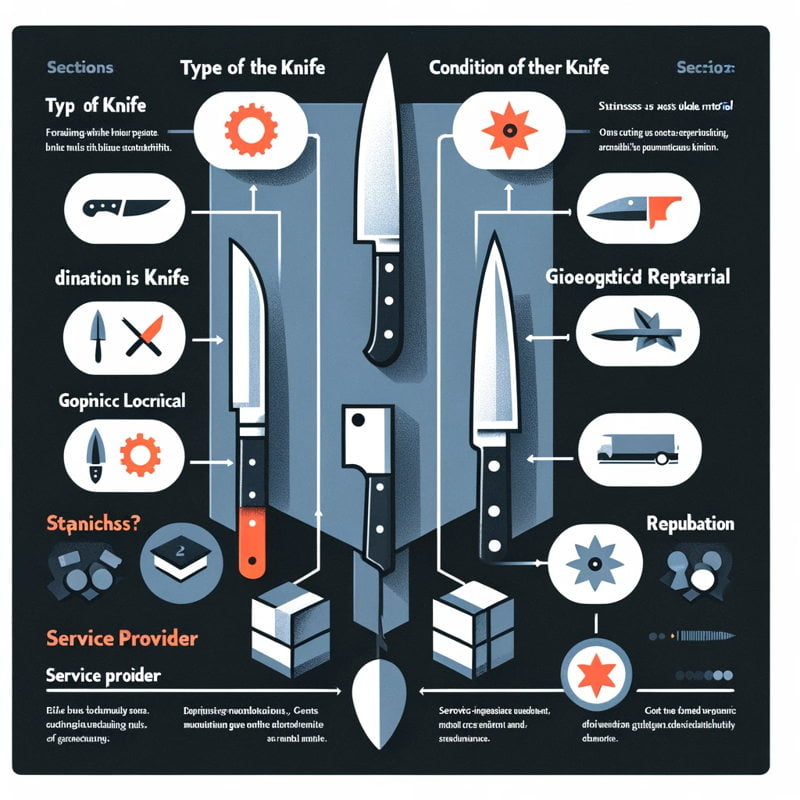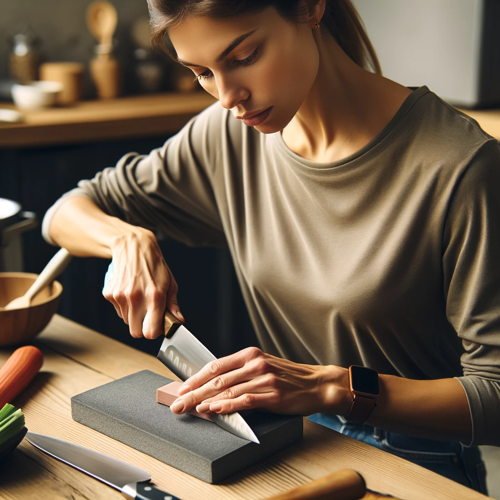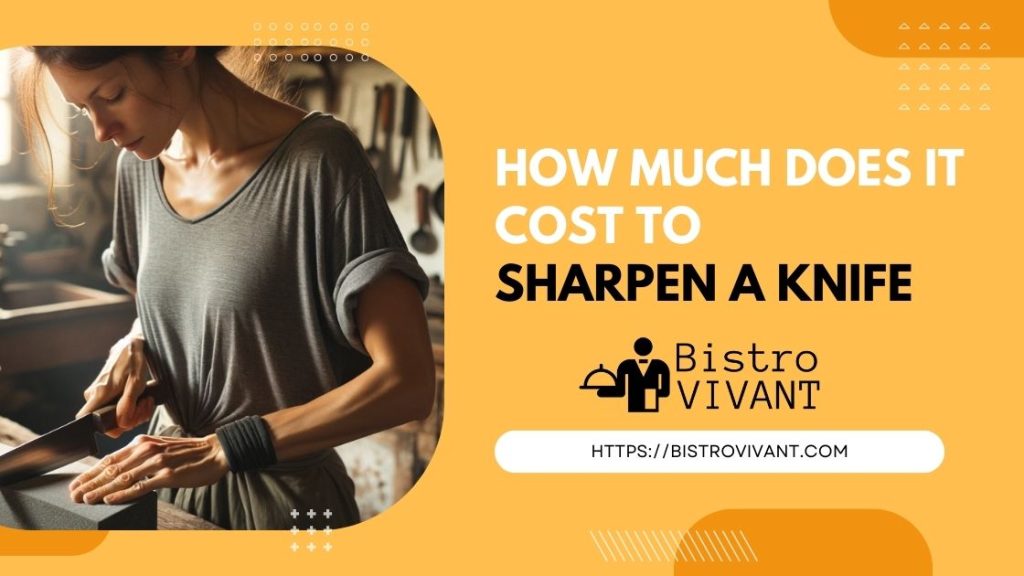Sharpening a knife is a crucial skill for maintaining your kitchen tools. It keeps your knives in top condition, ensuring they are always ready for efficient cutting. The cost of knife sharpening can vary depending on several factors, such as the type of knife, the method of sharpening, and the service provider.
Understanding the need to sharpen a knife is vital. A well-sharpened knife not only makes cutting easier but also safer. Blunt knives require more force, increasing the risk of accidents. Factors influencing the cost include the knife’s material, the sharpening technique (like using a whetstone or a professional service), and the blade’s condition.
Factors Influencing the Cost of Knife Sharpening
When considering the cost of sharpening a knife, several factors play a significant role. These factors determine how much you will spend to get your blade back in top shape.
Type of Knife and Blade Material
The kind of knife and the material of its blade significantly impact the sharpening cost. Different materials, like stainless steel or ceramic, require specific sharpening techniques. High-end knives or those with specialized blades often come with a higher price tag for sharpening due to the care and precision needed.

Condition of the Knife
The current state of your knife is crucial. A blade that’s heavily dulled or damaged might need more work, increasing the sharpening cost. Regular maintenance can reduce these costs over time.
Geographic Location
Where you live can affect the price of knife sharpening services. In urban areas or places with a higher cost of living, prices may be higher compared to rural areas.
Service Provider’s Expertise and Reputation
The skill and reputation of the person or company providing the sharpening service also influence the cost. Experienced professionals with a proven track record might charge more, but they often provide superior service.
DIY Knife Sharpening: An Alternative Approach
Sharpening a knife at home is an interesting task. It can save money and also be a satisfying skill to learn. However, there are some costs and efforts involved.
Sharpening stones and tools are the main expenses in DIY knife sharpening. The price can vary depending on the quality and type of stones. High-end stones are more costly, but they offer better results and longevity.
The learning curve is another aspect to consider. It takes time and practice to sharpen a knife effectively. At first, you might not get the perfect edge, but with practice, your skill will improve.
Comparing the costs of DIY with professional sharpening services is crucial. Professional services can be more expensive in the short term, but they save you the time and effort of learning the technique.

To start sharpening your knife at home, follow these steps:
- Choose the right stone. Select a sharpening stone suitable for your knife type.
- Prepare Your Stone: If it’s a water stone, soak it in water for about 10–15 minutes.
- Find the Right Angle: Hold the knife at the correct angle against the stone.
- Start sharpening: Gently slide the knife across the stone in a sweeping motion.
- Check the sharpness. Test the sharpness and repeat the process if necessary.
- Clean the Knife: After sharpening, clean the knife properly.
Remember, consistency and patience are key to DIY knife sharpening. It’s a skill that improves over time. The satisfaction of using a knife you’ve sharpened yourself is well worth the effort!
Sharpen a Knife: Professional vs. DIY
When considering knife sharpening, it’s important to compare the costs of professional services against doing it yourself.
Professional Knife Sharpening Costs
| Service Type | Average Cost |
|---|---|
| Basic Sharpening | $5 – $10 |
| Advanced Sharpening | $20 to $30 |
| Specialty Sharpening | $40+ |
Professionals often charge based on the knife’s size and the sharpening complexity. Prices can vary, but these are common ranges.
Long-term Costs of DIY Sharpening
| Equipment Type | Initial Cost | Maintenance Cost (Yearly) |
|---|---|---|
| Whetstone | $30 to $70 | $0 to $10 |
| Electric Sharpener | $70 to $200 | $10 – $20 |
| Sharpening Steel | $15 to $40 | $0 – $5 |
DIY sharpening requires an upfront investment in tools. Over time, these costs can be more economical.
Pros and Cons
Professional Sharpening:
- Pros: Expert-level sharpness; no need for personal skills or tools; time-saving.
- Cons: higher long-term cost, reliance on service availability, and less control over sharpening style.
DIY Sharpening:
- Pros: cost-effective over time; skill development; complete control over sharpness.
- Cons: initial cost of tools; learning curve; time investment.
Choosing between professional and DIY knife sharpening depends on your budget, time, and willingness to learn a new skill. While professional services offer convenience, DIY sharpening can be more satisfying and economical in the long run.
Conclusion
The cost of sharpening a knife can vary depending on several factors. It’s important to consider the type of knife, the sharpening method, and the professional’s expertise. Typically, prices range from a few dollars for basic sharpening to higher fees for specialized services.
Remember, maintaining your knife not only ensures its longevity but also enhances safety and efficiency in use. Investing in regular sharpening can save you money in the long run by keeping your knives in top condition, thus avoiding the need for frequent replacements.
Whether you opt for a professional service or invest in a good-quality sharpener for at-home use (if you wish to sharpen a knife like a pro), keeping your knives sharp is a wise and economical choice.
 https://bistrovivant.com is a participant in the Amazon Services LLC Associates Program, an affiliate advertising program designed to provide a means for website owners to earn advertising fees by advertising and linking to Amazon (.com,.co.uk,.ca, etc.) and any other website that may be affiliated with the Amazon Service LLC Associates Program. As an Amazon Associate, I earn from qualifying purchases.
https://bistrovivant.com is a participant in the Amazon Services LLC Associates Program, an affiliate advertising program designed to provide a means for website owners to earn advertising fees by advertising and linking to Amazon (.com,.co.uk,.ca, etc.) and any other website that may be affiliated with the Amazon Service LLC Associates Program. As an Amazon Associate, I earn from qualifying purchases.

